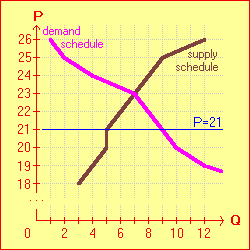One of the most common forms of intervention is a maximum price control, also called a price ceiling. Such controls are typically enacted either because of a clamor for lower prices or because high prices (e. g., from inflation, discussed later) have become politically embarrassing. A maximum price control is a law or edict prohibiting exchanges at prices over a specified level.
The diagram at right shows the cows-for-hens market that we analyzed earlier. The free-market price of a cow is 23 hens. Obviously, a price ceiling higher than 23 hens would have no direct effect on this market; there would thus be no political motivation, for example, to set a price ceiling of 25 hens, which would do nothing to appease cow buyers indignant over high prices. Hence the price ceiling is generally set below the free-market price, perhaps at 21 hens, as indicated by the blue horizontal line. ![]()
